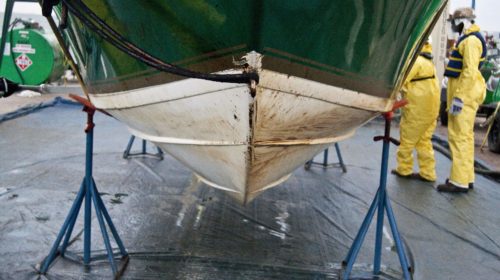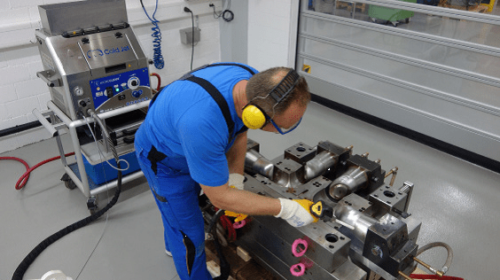
Mold removed from attic and crawl space without chemicals
THE SITUATION
The team at Adrian Environmental are experts in improving indoor environments. They are often called upon to remove mold from the attics and crawl spaces of residences. Dr. Neal Adrian is owner of Adrian Environmental and holds a Ph. D. in Microbiology from the University of Oklahoma. He says that the crawl spaces in the Midwest are guaranteed to fail because they are easy sources of moisture, mold and odors.
“Even in a dry crawl space without standing water, a lot of moisture collects due to the high humidity,” he said.
Dr. Adrian points out that the lumber industry has changed in the last decades so homes are no longer constructed the way they used to be. For example, a 100-year old farmhouse was built with better construction techniques, materials and lumber than a newer home that is five years-old. The older homes are more resistant to mold growth because they have plaster walls, versus the drywall used in newer homes which is made from paper products. Older homes are also constructed from dense heartwood from mature trees which has a natural resistance to mold growth. Newer homes are often constructed with wood from young trees grown on tree farms; these have not yet gone through the full maturation process. This sapwood is more susceptible to mold growth.
“An older home can hold up to 500 gallons of moisture without any damage or mold issues,” said Dr. Adrian. “However, newer homes can only absorb about 50 gallons of water before mold begins forming. So it is not unusual for homes that are just five years old to see mold growth.”
In crawl spaces and attics where it is damp year-round, surface mold growth often appears on the wood components. While this is a source for indoor air quality issues, if left unchecked it can also lead to wood rot and become a structural problem.
THE PROBLEM
In attics with heavy mold growth, homeowners sometimes mistakenly assume their roof is leaking, and call a roofer.
“When the roofer sees the mold in the attic, they often recommend that the only way to salvage the decking is to replace it,” said Dr. Adrian. “In other words, they must tear off the shingles, remove the decking, install new decking and reshingle. This can be cost prohibitive.”
For those who choose to remove the mold, cleaning the mold growth from the sheathing on the underside of the attic roof can prove to be difficult, and the sheathing will often retain some of the mold’s pigmentation, leaving the wood discolored and stained.
It is also difficult to get into the tight recesses of crawl spaces and attics – there are many uneven surfaces and areas where shingle nails poke through; so cleaning these areas can be challenging.
The traditional method of removing mold from the wood in attics and crawl spaces is through the time consuming process of sanding or using wire brushes. Disinfectants and cleaning solutions can also be used. However, this method is very messy because the solution drips onto workers. In addition, the chemicals introduce odors into the home, making it unpleasant for those living there. Sanitizing chemicals also add moisture back into the wood, making it hard to later apply mold resistant sealants. Finally, if the area is not properly sanitized the mold is often still there and can later cause problems.
THE SOLUTION
Using the Cold Jet Aero 40 dry ice cleaning solution, Dr. Adrian and his team are able to completely remove mold from attics and crawl spaces. Cold Jet’s dry ice cleaning system uses non-abrasive media in the form of recycled CO2 pellets that won’t damage surfaces. The dry ice media, blasted using pressurized air at user-controlled speeds, sublimates upon impact with the surface being cleaned, lifting away mold and contaminants safely, without leaving behind any secondary waste.
Dry ice cleaning is odorless, does not add moisture back to the wood and can be done cleanly, with no solutions dripping on the workers.
THE RESULTS
The team at Adrian Environmental was recently asked to clean a 1,620 square-foot attic that had very heavy mold growth over 80 percent of the sheathing. One hundred percent of this mold growth was removed using dry ice cleaning from Cold Jet, and in just one pass with the applicator.
“If we had instead used chemical removal, the cleaning would have required two passes, with a third pass to remove staining from stubborn areas,” he said. “Cleaning with chemicals would have added an additional day of cleaning to the overall job. In addition, there would have been staining remaining in the areas with the heaviest mold growth.”
Adrian pointed out that these black mold stains are hard to tackle with traditional methods, but are completely removed with dry ice cleaning. In addition, the dry ice cleaning allows his team to easily access tight areas; it does not matter how many shingle nails poke through – the dry ice technology cleans around them thoroughly.
On a separate crawl space job, Adrian’s team tackled 1,225 square feet of mold growth. It took two days to remove the mold, versus the three days that would have been spent using a chemical treatment.
“Had we not used dry ice cleaning, the crawl space – including the floor joists – would have been a wet mess from the cleaning solution,” said Dr. Adrian. “The surface of the wood would have been less than ideal for later applying the mold resistant coating. A huge advantage with dry ice cleaning is that it doesn’t add moisture to the wood components, which is what is facilitating the mold growth in the first place, plus the dry ice blasting better prepares the surface for later application of the mold resistant coating.

